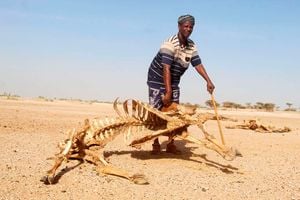Why climate change could spark the next major pandemic

Locals extinguish the edge of a burning area to stop the spread of fire at Aberdare National Park on February 7.
What you need to know:
- In a new study, scientists say in the next 50 years, the devastating effects of climate change will be a key driver of over 15,000 viruses jumping from one mammal to another.
- The scientists call this phenomenon a zoonotic spillover.
As the blade of the ongoing Covid-19 pandemic becomes blunt by day; evident in the low positivity rate recorded in months, scientists have been working round the clock to predict a cause of a future pandemic. Their verdict — climate change.
In a new study published at the end of last month in the scientific journal Nature, scientists say in the next 50 years, the devastating effects of climate change will be a key driver of over 15,000 viruses jumping from one mammal to another.
The scientists call this phenomenon a zoonotic spillover.
While it is not new for viruses to jump from non-human mammals to humans, making people sick, climate change will exacerbate the situation.
Even in the ongoing pandemic, some researchers believe that the SARS-Cov-2 (coronavirus) may have been transmitted by bats, but it is still a debate yet to be settled on. The Spanish Flu, which was the other major pandemic the world ever had in 1918, was also described as an avian influenza virus, which means it was transmitted from birds.
The new research now shows that climate change will not only make our planet inhabitable due to unbearable heat, frequent flooding, rising sea levels and so much more, but these effects will also affect the mammals that will move from their habitat carrying diseases and transmitting them to people.
“Among the thousands of expected viral sharing events, some of the highest risk zoonoses or potential zoonoses are likely to find new hosts. This may eventually pose a threat to human health,” explained the study. “If species range shifts can keep pace with climate change, we predict that the vast majority of mammal species will overlap with at least one unfamiliar species somewhere in their potential future range, regardless of emissions scenario.”
Colin Carlson, one of the researchers who took part in the study, posted a tweet saying despite the number of years that the research took, their study is ‘dense and technical, but the results are horrifying and urgent.’
The researchers also predicted the areas likely to be origins of the new pandemic should the devastating effects of climate change come alive. The Rift Valley is one of those areas.
“We predict that tropical hotspots of novel viral sharing will broadly coincide with high population density areas in 2070, especially in the Sahel, the Ethiopian highlands and the Rift Valley, India, eastern China, Indonesia, and the Philippines,” said the study.
The twist in this study is that forests will be less likely to be culprits of the new and emerging viruses that could potentially blow up and cause pandemics.
“Potential first encounters are disproportionately likely to occur in areas that are projected to be either human settled or used as cropland and less likely to occur in forests despite current literature, suggesting that forests harbour most emerging and undiscovered viruses,” explained the researchers.
In Climate spaces, mitigation of the distressing effects, among other things, has been touted as the way out to maintaining global temperatures to a less than 1.5 degrees Celsius. On the flip side, this study faults that in relation to viral transmission.
“Whereas most studies agree that climate change mitigation through reducing greenhouse gas emissions will prevent extinctions and minimise harmful ecosystem impacts, our results suggest that mitigation alone cannot reduce the likelihood of climate-driven viral sharing,” says the study
“Instead, the mildest scenarios for global warming appear likely to produce at least as much or even more cross-species viral transmission — when warming is slower, species can successfully track shifting climate optima, leading to more potential for range expansion, and more first encounters.”
Moving forward, the researchers say urgency is the only way out. “Our results highlight the urgency of better wildlife disease surveillance systems and public health infrastructure as a form of climate change adaptation even if mitigation efforts are successful and global warming stays below +2 degrees Celsius above pre-industrial levels,” they say.
As the study was submitted in January 2020 when coronavirus was starting to spread across the world, the researchers argued in their paper that climate related viral sharing may have been realised.
“These findings suggest that in a world that has already passed more than one degrees Celsius of global warming, the majority of climate-related opportunities for novel viral sharing may already have been realised—if and only if species’ dispersal has kept pace with shifting habitat suitability. That premise, and particularly our simulation of bats as unconstrained by dispersal limits, is more tenuous over smaller timescales; research that estimates the real-time signal of climate-attributable range shifts is urgently needed,” they say.
Urgency on why climate change should be slowed down has been repeated time and again and now the researchers also warn that it could cost at least one billion dollars to study and prevent zoonotic threats from wildlife before they spill over to human beings.





